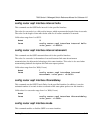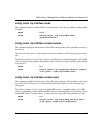
7000 Series L3 Managed Switch Reference Manual for Software v2.0
Routing Commands 8-19
Router ID Is 4 digit dotted decimal number representing the neighbor inter-
face.
IP Address Is an IP address representing the neighbor interface.
Neighbor Interface Index Is a slot.port identifying the neighbor interface index.
show router ospf stub table
This command displays the OSPF stub table. The information below will only be displayed if
OSPF is initialized on the switch.
Format show router ospf stub table
Area ID Is a 32-bit identifier for the created stub area.
Type of Service Is the type of service associated with the stub metric. The
GSM73xx L3 Switch only supports Normal TOS.
Metric Val The metric value is applied based on the TOS. It defaults to the
least metric of the type of service among the interfaces to other
areas. The OSPF cost for a route is a function of the metric value.
Metric Type Is the type of metric advertised as the default route.
Import Summary LSA Controls the import of summary LSAs into stub areas.
show router ospf lsdb summary
This command displays the link state database. This command takes no options. The information
below will only be displayed if OSPF is enabled.
Format show router ospf lsdb summary
Router ID Is a 32 bit dotted decimal number representing the LSDB inter-
face.
Area ID Is the IP address identifying the router ID.
LSA Type The types are: router, network, ipnet sum, asbr sum, as external,
group member, tmp 1, tmp 2, opaque link, opaque area.
LS ID Is a number that "uniquely identifies an LSA that a router origi-
nates from all other self originated LSA's of the same LS type."
Age Is a number representing the age of the link state advertisement in
seconds.
Sequence Is a number that represents which LSA is more recent.
Checksum Is to total number LSA checksum.
Options This is an integer. It indicates that the LSA receives special han-
dling during routing calculations.


















